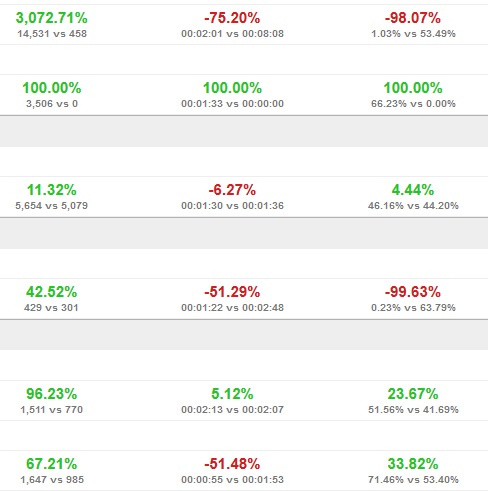Your cart is currently empty!

A Deeper Look with Google Analytics
Some things in Google Analytics are obvious at first glance. Google even helpfully puts the good stuff, like increasing traffic, in green and the things to worry about in red.
Some things are not so obvious. We had a couple of great examples of that recently.
Example 1: falling search traffic
During a recent site audit we saw what appeared to be a decrease in search traffic. Direct traffic had increased significantly, but direct traffic is often internal, so this looks like bad news.
There are many possible reasons for a drop in search traffic:
- A change in the search engine algorithm
- Changes on the site, such as an unwise rewrite or redesign
- A reduction in searches for the primary keyword
- New competitors whose website outperforms our website
In this case, we had also noticed a stunning rise in mobile traffic. Fortunately, Josepha remembered that iOS6 traffic was being misidentified by Google analytics.
Direct traffic reaches Google Anaytics with no markers showing where it was before it arrived — no indication that it was a referral from another site or from a search engine. That means that any traffic that can’t be identified correctly will end up in Direct traffic. For many devices that use Apple software, the switch to iOS6 meant that searches were misidentified. A site with a lot of traffic from Apple devices could see a jump in Direct and a drop in Search, even though there was no real change.
When we checked the quantity of iOS traffic to the site and the timing of the changes, this seemed like the likeliest explanation. This situation will probably correct itself.
Example 2: rising conversions
Often, people look closer when they see a problem in their analytics but just smile at good news and move on. In this case, however, it looked as though traffic from Bing was converting way ahead of traffic from Google. Our client wondered whether we should be working harder to optimize for Bing.
This isn’t usually an issue. For one thing, Bing has much the same criteria as Google. While the two appear to use social media information differently, both want to offer searchers a high quality website that is relevant to their search. What’s more, Bing is the search choice of about 17% of the population, so it’s less important overall than Google.
However, if your Bing traffic is converting better than your Google traffic, then you should care more about Bing than you otherwise might.
So we went in to have a look.

If you look in Google Analytics for Traffic Sources> Search> Organic, and choose Source as the Primary Dimension as shown in the screenshot above, you’ll see a list of the search engines your visitors use. Click on Source to get an alphabetical list and you can easily find your Bing users. Click on “bing” and you’ll be able to look more closely at those specific visitors.
When we did this for our client, we saw that the average conversion rate for these visitors was indeed higher. However, when we explored these visits further, we found a surprise: it wasn’t that Bing visitors in general had a slightly higher conversion rate — say a 6% rather than a 4% rate. What we saw was that Bing users from specific cities would have a 50% or 100% rate of conversion. These cities would have a single visit with conversion, or two visits close in time, the first without a purchase and the second with a purchase.
We didn’t see this with cities that sent more traffic — and we didn’t see it with Google. The reason in both cases is that the numbers were too large for us to be able to see such specific patterns. The same human actions were probably taking place elsewhere, too, but they weren’t visible in the mass of other actions.
So we looked to see what Bing users might have in common that would make them more likely to convert. We soon saw by checking the networks (Audience> Technology> Network) that one corporate network was far more likely to use Bing than the average. Could it be that people using this network were also more likely to use Bing at home?
And could it be that people working with this company were more likely to convert than the average person? The answer to that was a definite yes.
In this case, we’re probably not looking at a situation in which people who use Bing to search are more likely to want our client’s goods. We’re looking at a situation in which people who want our client’s goods are more likely to use Bing to search.
We checked the keywords bringing the Bingers to the site and saw no surprises there, so our necessary action is to install Bing Webmaster Tools and make sure we continue to rank well at Bing — and to cozy up to that corporation.
In both these examples, the first — most obvious — conclusion was false. Action taken based on the false conclusions would be a bad choice. The takeaway? Look more closely before you make decisions.
by
Tags:

Leave a Reply